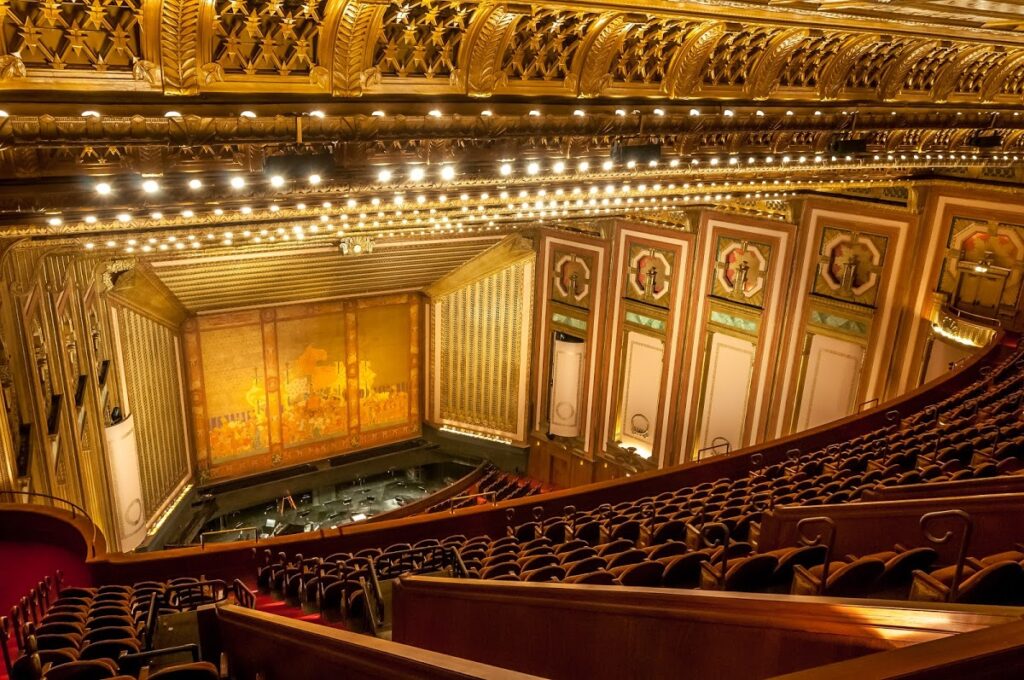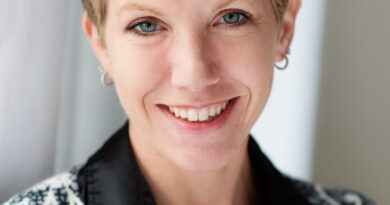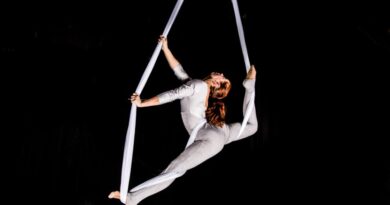Pandemic Pallor Sets In with Shutdowns Shutting Audiences Out of Area Arts Venues
“It’s extraordinary that our world should have been turned upside down in such a short amount of time,” sighs Anthony Freud, Lyric Opera’s general director and CEO as he recounts the days before and after having to cancel the Lyric’s much anticipated Ring Cycle. “But we always have to remember that this is a national and a global tragedy in which we, Lyric Opera, are a tiny microcosm.”
That kind of perspective from the head of an organization that spent much of the last ten years preparing for The Ring–what Freud once called, “the most massive challenge any opera company can undertake”–is indicative of the spirit of generosity and awareness Chicago’s arts community is exhibiting throughout the COVID-19 pandemic. Artists and organizations are keenly aware that this disaster is affecting the entire world, not just them.
While people are clear that they’re grieving over lost performances and are stressed by financial uncertainty, what’s most apparent in talking with Chicago actors, musicians, administrators, dancers and audience members is that artists will find a way to make art, and audiences will find a way to embrace it. Whether artists are helping each other learn new technology for streaming performances, companies are figuring out ways to offer content to their audiences or the city and state are coming together to create the four-million-dollar Arts for Illinois Relief Fund, Chicago arts and arts-enthusiasts are proving to be resilient and determined to find ways to take care of each other.
For Rich Regan, CEO of the Auditorium Theatre, that determination includes prioritizing paying employees for some of the work they missed due to performances that didn’t take place. “We decided to pay our front of house staff–ushers, bartenders, etc.–for shows that were scheduled in March that we weren’t able to put on because of the shutdown,” he explains. “We’re looking at ways we can continue to support them. We’re trying to support staff for as long as we can.”
Other organizations have found ways to continue to serve clients (and generate some revenue) thanks to online programming. The Music Institute of Chicago (MIC) went from providing hundreds of in-person lessons to serving their students across a variety of distance-learning platforms. “We have 150 teachers on various platforms teaching their students without missing a beat,” shares MIC President and CEO Mark George. “Teachers are in excellent spirits. I shouldn’t be surprised by that. They’re a very positive, gung-ho group.”
Other organizations are offering free or donation-based options for their constituents. Deeply Rooted Dance Company launched Deeply Rooted Dance Theater Beyond Dance–a program featuring a wide-variety of dance classes and discussions for dancers and audience members.
After having to end performances of its production of 2666 early, The Goodman Theatre is offering free unlimited streaming of the show through its website. Steppenwolf is also offering free virtual events each week for educators, teens and early-career professionals.
John Collins, managing director for Goodman Theatre adds, “We are working with artists and staff to assemble a lineup of world class theater to offer live audiences when it is safe to do so. In the meantime, during this intermission, Goodman is offering a suite of virtual programming, including streamed versions of full length plays, live performances, and a plethora of education and engagement programs.”
Both Lyric Opera and Auditorium Theatre have found ways to connect with audiences fairly seamlessly, beefing up existing online platforms and thinking creatively about just what they can offer audiences looking for something to take their minds off of the current state of affairs. Audiences can find favorite moments from past Lyric Opera productions on their website, and Auditorium Theatre has expanded their Aud Talk podcast into a weekly video series.
Says Regan, “Everybody’s at their house and pining for those times when we can all appreciate live performance again.”
The Music Institute of Chicago is taking things just a step further in trying to connect with their patrons. Having a strong commitment to service, MIC usually devotes a wealth of time to visiting senior centers and playing for music lovers who might not be able to attend concerts at a concert hall due to mobility or health issues. Since those in-person visits aren’t exactly possible right now, MIC is using old-fashioned landlines to bring music to those who need it most.
Recently, 14 year-old violinist Esme Arias-Kim had the opportunity to perform a short piece for a senior citizen. Arias-Kim explains, “Once we got connected, I played a piece called Estrellita. It’s a small violin encore. I wanted to play this piece because, in this very strange and uncertain time, it brings me a lot of peace, and it’s really beautiful. So I thought it was a really good fit.” She further notes, “One of the ladies said she was getting ready for her afternoon nap, and she said it was the perfect piece to bring her into calm.”
The phone has become an important tool for See Chicago Dance’s Surinder Martignetti, also. Not because the artists she serves don’t have other technologies available, but because she’s seeking out more personal connections when so many things are moving online. Says Martignetti, “I’ve been really sensitive to all of the emails people get, so I’ve been making phone calls…That’s been as helpful for me personally, as it has for the people I’ve been reaching out to.”
Martignetti is also helping teaching artists find ways to reach out to students who don’t have very much access to technology. Sharing lessons through the mail or finding ways for students to connect to the arts with minimal supplies is vital to nurturing creativity. She notes, “It’s a way to deepen connection in parts of the community that you live and work in.”
She’s also wondering whether artists are feeling too much pressure to create during such a stressful time, confiding, “We’re talking a lot about loss and grief. We’re grieving the loss of stability and income and livelihood. All of these different parts of loss that we’ve got to deal with. I’m reminding everyone and myself that it’s OK to take a break. All of these emotions are important and valid.” She continues, “I’m exhausted, and I’m trying to be transparent about that. I don’t have all of the answers, but I’m asking the questions and maybe that’s enough.”
Individual artists are definitely feeling the stress and asking their own questions about what’s next for them on an artistic level and, more frankly, in terms of survival. Chicago writer, director and performer Jerre Dye worries, “I think arts folks are focused on potential food scarcity and health care for themselves, their friends and their neighbors. Artists know how to live modestly, but this? It’s just hard to know what we’re looking at. I already see people struggling, worried about basic needs. We are several jobless weeks in now and things are scary for many, many folks. Isolation creates so many invisible stories.”
Financial losses are already devastating for companies and individuals. The Lyric Opera alone estimates losses of at least 15 million dollars in the first month of the shelter in place order. While the Lyric and other large institutions will surely find a way to survive, smaller organizations and individual artists are struggling and will continue to struggle. Pay cuts and closures are likely. Chicago has already lost the beloved Lou Conte Dance Studio as a direct result of COVID-19.
For people who want to support artists during this challenging time, they can certainly donate to their favorite arts organizations or to the Arts for Illinois Relief Fund (artsforillinois.org). Additional support for arts professionals is available through The League of Chicago Theatre’s Chicago Theatre Workers Relief Fund (chicagoplays.com/chicago-theatre-relief-workers-fund), which has already granted more than $100,000 directly to unemployed theater workers according to League Chair John Collins.
Additionally, a coalition of national grantmakers, consisting of Academy of American Poets, Artadia, Creative Capital, Foundation for Contemporary Arts, MAP Fund, National YoungArts Foundation and United States Artists, created Artist Relief, a fund for artists facing dire financial circumstances due to COVID-19 (artistrelief.org). The City of Chicago even has a dedicated webpage for COVID-19 Arts Relief & Resources.
All of these funds are accepting donations and applications for grants. That kind of financial support is vital and meaningful, and it will help local artists in the long-run.
Artists, however, are in need right now. Many are applying for funds through the Arts for Illinois Relief Fund and other grantors, and freelancers are hoping that they’ll be able to collect unemployment–something that isn’t usually available to freelance and contract workers. Applying for and ultimately receiving those funds takes time–time that not every artist has.
Kyra Leigh, a freelance musician, teacher, and performer in Chicago, wants to remind people that they can support artists directly. She explains, “One way to support artists is to purchase their merch (CDs, art, etc.) or donate to their Venmo or similar accounts.”
Artists like Leigh are participating in virtual open mic nights and Facebook cabaret events. She laments, “I know just trying to stay creative is a challenge right now. A lot of us are turning to online resources like Zoom or streaming platforms to meet, teach, and/or share our art. It can come with its own challenges like dealing with technology and virtual burnout. Even though it does supply a level of connection, it doesn’t beat in-person.”
That in-person connection is something most artists are missing, but everyone is cautiously optimistic about being in the same space again soon. Many arts education programs are planning summer programming with the hope that students and teachers can be together and the understanding that it might not be possible. Because of that uncertainty, organizations are planning for both possibilities.
Likewise, performing venues are planning with their eye on something that looks like a normal season, but recognizing that no one knows what “normal” is.
The Lyric’s Anthony Freud elaborates, “We, as artists, are programmed to deal with problems and find solutions. One of the things that has been so unnerving has been the inability to form an instinct about what is going to happen next.”
Although no one knows exactly what the future holds in terms of the Chicago arts community and its recovery from this unprecedented situation, most artists know they want to continue making art, telling stories, and stirring emotions in audiences. Jerre Dye agrees. “What we do know is that telling of stories becomes even more important in a climate like this. Essential. Everyone on planet earth is simultaneously facing fundamental questions of life, death, grief like never before. We are, at this moment, connected like never before. There are so many important stories unfolding in real time just now, big and small.”
Dye continues, “Just three days ago my family participated in the last rites of a dying loved one via Zoom. Where does one put this? What effect does this have on the soul? When the first collective breath finally does happen, what kind of content will audiences need? My guess is folks will crave simple connection, authentic narratives with heart. and some meaningful ways to escape. I do know that we all have some important cultural/spiritual/emotional work to do as we move forward. I also know that artists will lead the way.”
Despite the sadness and disappointment over canceled productions, concerts and classes, artists are, indeed, leading the way, finding creative methods to connect with each other and with the people of the City of Chicago to offer comfort and support.
In a very visible way, Chicago Mayor Lori Lightfoot is reminding Chicagoans how valuable the arts are with her weekly “Sunday Arts Takeover” events via Instagram. Gospel singers, DJs, musicians and more are front-and-center for these live events that are designed around continued support for the Arts for Illinois Relief Fund. Mayor Lightfoot’s handle is @ChicagosMayor for those who wish to tune in and support local performers.
Behind the scenes, artists are trying to take care of one another. They’re making phone calls, texting each other checking in to see if people need something from the supermarket. They’re swapping tips for navigating the unemployment website and proofreading grant applications for one another. They’re trying to look toward the future while still grieving the work they didn’t get to finish. Artists–especially performing artists–really miss the thrill of being in the room with an audience, and they’re hoping that when the dust settles, audiences will return. In the meantime, artists are making art online, at home and for the future.
Artists are looking forward to getting back to normal, and there is a lot of work being done on that front. Many of the bigger producing companies in Chicago have been able to postpone shows and reschedule their programming for future seasons. Houses that bring in tours have been fortunate that, since literally everyone in the world is affected by this pandemic, booking agents are working collaboratively with venues to find new dates for concerts, tours and speaking engagements. Dates for upcoming shows might only be penciled in at the moment, but at least they’re on the calendar.
Kevin Iega Jeff, co-founder and Creative Director of Deeply Rooted Productions/Deeply Rooted Dance Theater shares, “We are looking to the future with inspired optimism as we plan for future programming; including our Summer Dance Intensive and Emerging Choreographer’s Showcase; preparation for the company’s fall season at the Reva & David Logan Center for the Arts; and rescheduling the premier of GOSHEN.”
The Lyric’s Anthony Freud cautions people to manage their expectations, however. “My sense is that the one thing we really have to acknowledge is that the new normal is going to be fundamentally different than the old normal.”
While it may be awhile until we know just what that new normal is, Freud echoes the sentiments of virtually every other artist interviewed for this piece simply, in these words: “I’m profoundly optimistic.”




